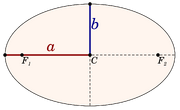
In an elliptical orbit, the orbital parent is located at one of the focus points (F1 or F2). The semi-major axis, a, is half of the longest diameter of the ellipse. Source: Wikimedia Commons
The Semi-Major Axis of an object's elliptical orbit is the distance from the center of the ellipse to the most distant point in the orbit. In other words, the Semi-Major Axis is half the distance between the pericenter and apocenter of the orbit. Semi-Major Axis is a way to represent the size of an orbit; objects with a smaller Semi-Major Axis will orbit closer to their Orbital Parent than objects with a larger Semi-Major Axis.
The Semi-Major Axis of an object with a hyperbolic trajectory is negative.
Semi-Major Axis is one of the six orbital elements that described an object's orbit.
Property Details
Location
The Semi-Major Axis property is located in the Orbital Elements section of the Motion tab of an object's properties panel, if that object has an Orbital Parent.
Units
Semi-Major Axis can be viewed and edited using the following units:
- Milky Way Galaxy radius (milky way) = 5.5×104 light year
- Parsec (parsec) = 3.08568025×1016 m
- Light-year (light year) = 9.46073047×1015 m
- Astronomical Unit (AU) = 1.495978707×1011 m
- Solar radius (sun) = 6.955×108 m
- Lunar distance (lunar dist) = 3.844×108 m
- Light-second (light sec) = 2.99792458×108 m
- Jupiter radius (jupiter) = 6.9911×107 m
- Earth radius (earth) = 6.37101×106 m
- Moon radius (moon) = 1.7371×106 m
- Kilometer (km) = 1000 m
- Meter (m) is the SI base unit for length
- Centimeter (cm) = 0.01 m
- Millimeter (mm) = 0.001 m
